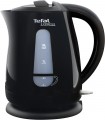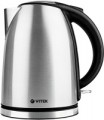Volume
The nominal capacity of a kettle refers to the maximum amount of water that can be safely poured into it, and it is typically indicated by the water level indicator. In the case of brewing sets (see "Type"), the nominal capacity refers to the main kettle, while the capacity of the teapot is listed separately (see below).
The capacity of the electric kettle directly affects the amount of water that can be heated at once. A larger capacity allows for heating more water, but this also means the kettle will be larger and heavier. Additionally, heating a larger volume of water requires either more power or a longer time. Therefore, it is important to consider one's actual needs when choosing a kettle based on its capacity. For example,
mini-kettles for travelling (or for one person) have a volume of up to 1 liter. For home use in a family of 2 – 3 people, a 1,5 – 2 liter model is enough. Devices for
2 – 3 liters are already well suited for a small office or a similar situation. The most spacious electric kettles are designed to hold 10 liters or more, and are typically used in public places such as canteens and cafes for dispensing hot water.
Controller
The name of the controller installed in the device.
The controller is called an electronic circuit, which is directly responsible for managing the operation — primarily for turning off the heating when boiling or turning on without water. In our catalog, the name of such a circuit is specified if we are talking about an advanced controller that significantly exceeds most solutions on the market in terms of quality and reliability. At the same time, the specs indicate not a specific model, but a general brand — this is quite enough in this case.
The most reliable, durable and safe nowadays are the controllers of the British manufacturers Strix and Otter. There are no fundamental differences between these options in this regard, any of them is a sign of a quality kettle (even if the overall functionality of the device is rather modest). On the other hand, such equipment affects the price.
Material
The main material of the kettle.
Note that this paragraph primarily considers external material; the inner coating may differ from it. As for specific options,
metal (usually steel),
plastic and
glass products are the most popular nowadays. More rare are
glass with metal and
ceramics (including porcelain). Here is a more detailed description of the different materials:
— Steel. Stainless steel is a popular material for kettles due to its strength, stylish appearance, and non-corrosive properties. It is available in a wide range of price categories. However, steel's high thermal conductivity may increase energy consumption and create a risk of burns. Steel is also opaque, so transparent inserts are necessary to monitor water levels. It is not suitable for teapots as it can give an extraneous aftertaste to the drink.
— Plastic. Plastic kettles are inexpensive and can be produced in various colors and transparency. They have low thermal conductivity, which reduces the risk of burns when touched. However, plastic is prone to scratches and can fade over time. Inexpensive plastic models may emit an unpleasant smell and taste when heated, but higher-priced models may use better quality plastic or have a metal lining to prevent this issue. Some high-end plastic materials are available b
...ut cost more.
— Glass. Glass kettles have a visually appealing and transparent appearance, allowing you to easily monitor the water level without any special indicators. This is especially useful for teapots, as it enables the user to monitor the colour and saturation of the tea during the brewing process. Glass containers do not affect the taste or smell of the drink, which is highly beneficial for tea drinkers. Although glass is considered fragile, it is difficult to break such a container in reality. However, one of the downsides of glass containers is that any scale or contaminants inside the container are easily visible from the outside, requiring extra care to maintain their appearance. The thermal conductivity of glass is average, making it less prone to heat transfer than steel, but more so than many types of plastic. Therefore, touching a heated glass kettle should be avoided to prevent the risk of burns.
It should be noted that glass kettles often have parts made of materials other than glass. Usually, the top and bottom, as well as the handle, are made of plastic or a combination of plastic and metal. However, if these parts are mostly made of metal, the material is referred to as "glass with metal."
— Glass with metal. There are glass kettles that have metal top and bottom parts, with only a plastic insert in the lid for convenience purposes. These teapots are considered more advanced than the regular glass models that use plastic, as metal adds a sense of solidity and enhances durability. Also, since the contents of the kettle do not come into contact with plastic, the possibility of foreign tastes and odors is almost non-existent. However, such teapots are relatively expensive, although there are also affordable options available.
— Ceramics. Ceramics have a distinct advantage in terms of aesthetics as they offer a stylish appearance, making them an ideal choice for retro-style kettles or those with a classic design. Moreover, they are usually adorned with unique patterns and designs. Apart from their appearance, ceramic kettles do not affect the taste of the contents and provide excellent heat retention due to their thick walls. However, they are heavy and vulnerable to shocks, their opaque cases make it difficult to check water levels without opening the lid, and they lack water level indicators. Therefore, if appearance is a priority, ceramics can be an attractive option despite these drawbacks.
— Porcelain. Porcelain is a type of ceramic material that is highly valued for its prestigious appearance and is considered expensive. However, it is also fragile and requires delicate handling, which is why it is not commonly used in electric kettles.
